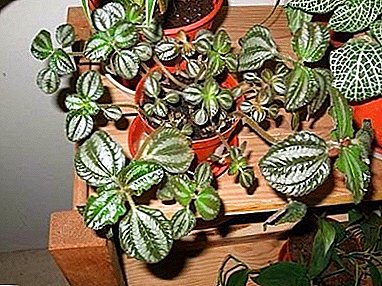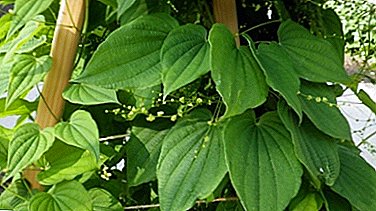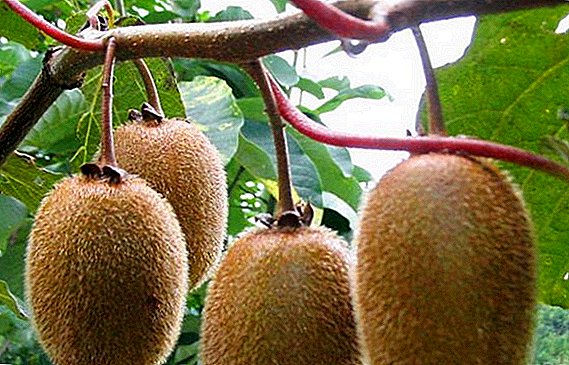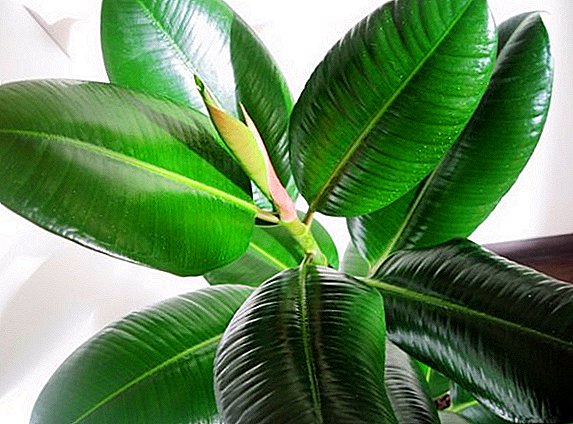 Every florist, who grows ficuses, wants to see beautiful branched trees, and even with intricately woven trunks.
Every florist, who grows ficuses, wants to see beautiful branched trees, and even with intricately woven trunks.
But not everyone knows how to form a ficus at home.
Moreover, these plants grow only upward and without human help the lush crown will not develop. We will talk about the methods and rules for creating a thick green crown.
Did you know? The ancestors of ficuses are typical for the Indian jungle 30-meter trees with giant horizontal branches and rounded meter leaves. In their shade, they can hide up to 300 square meters of land.
Description and features of culture
Of all the pot plants, rubber moths are distinguished by their popularity and impressive size. Outwardly, they are a straight-bore culture with woody shoots and large dark green leaves of elliptical shape.
A characteristic feature of the plant is single-stem and lack of skeletal branches. The tree rapidly stretches upwards, alternately releasing as the foliage grows, which at the beginning of development has a reddish-burgundy shade.  Over time, the leaf plates reach a length of 30 cm, and the trunk becomes a gray-brown color. In the wild, plants bloom, after which they form inedible spherical small fruits.
Over time, the leaf plates reach a length of 30 cm, and the trunk becomes a gray-brown color. In the wild, plants bloom, after which they form inedible spherical small fruits.
In room conditions, it is almost impossible to achieve budding, and it is not worth it, because flowers do not represent special value.
All the beauty of the plant is foliage. With home cultivation, ficuses can reach 10 meters in height. In the range, they are 3-4 times higher, moreover, over time, the trunk produces strongly developed aerial roots, which quickly reach the ground and take root.
If the houseplant is timely cut, it will develop a powerful trunk and a spherical crown. A specific feature of the flower is that its branches begin to grow from the buds, which are axillary and apical.
The latter are characterized by intensive growth, due to the concentration of culture hormones in the upper zone of the trunk. Therefore, if you do not interfere in this process, the escape will stretch to the very ceiling, the village and losing foliage from below.
Important! Often on the leaves of the plant stands a milky juice, consisting of enzymes, latex and alkaloids. Getting on the skin, the substance provokes strong irritation of the epidermis and allergic reactions.

Crown formation methods
Care for ficus rubber at home must necessarily include the formation of the crown. And this is done not only by the usual pruning of branches, but also in other interesting ways, without the participation of the shears.
At first glance it seems that the process does not require additional skills and knowledge, in fact, to all of the above, talent and patience are also needed. We will understand in more detail how to force a ficus to branch.
Formation of the crown is an important stage in the care of Scheffleroi, Clerodendrum, room fuchsia, Poinsettia, Chinese rose, room camellia, Croton, Korie, room boxwood, Calamondin
Ordinary
Any work aimed at the development of the side branches of the plant using conventional technology should be carried out from February to July. If you ignore this rule, the plant may have enough strength to develop a single sprout, the ficus in this case will grow only in one direction.
The method consists in pinching the top shoots of a young ficus. Experiments on old specimens can end up by destroying them, since waking up sleeping buds is very difficult.  Thus, from a straight stem, you can create a bush. For its even rounding flower growers are recommended to expose to the sun with different sides, occasionally turning the pot.
Thus, from a straight stem, you can create a bush. For its even rounding flower growers are recommended to expose to the sun with different sides, occasionally turning the pot.
Important! Ficus juice remaining on the instruments cannot be washed off.
Some craftsmen resort to using cytokinins - hormones that slow down the aging process of the plant body and without removal of the apical bud, stimulate the development of its lateral branches.
This method is very effective, because when processing hormonal substances do not delay leaf-declining processes, so that the lower zone of the flower remains covered with foliage.
You can do without additional funds by bending the thin barrel into an arc so that its tip is directed downwards. Then growth hormones will accumulate in the upper part of the bend, and the lateral buds will sprout. The disadvantage of this method is to slow the development of the stems.
Cytokinin paste is used mainly for such capricious plants as the orchid zinbidium, phalaenopsis, miltoniopsis, tselogin, violet, dracaena, hibiscus, camellia, even cactiYou can also influence the shape of the indoor tree crown by adjusting the lighting. This method is good for correcting malformed plants. Under direct sunlight they can get severe burns, but the scattered light from the south side is just what you need.
 Another effective way to make a tree branch is cut the bark over the kidney.
Another effective way to make a tree branch is cut the bark over the kidney.
Botanists call the technology kerbovka and advise making deep and wide cuts at the bottom of the woody trunk.
Did you know? In Ukraine, the "relatives" of the ficus rubber plant are widely cultivated - these are figs and mulberry trees.
Unusual (weaving, circular grating, shaping stem tree)
Sometimes the beautiful textures of ficus stems, created by florist, are breathtaking. It turns out that you can create such masterpieces at home.
In order to do ficus braidingFirst of all, it is necessary to plant several equally developed sprouts up to 15 cm long in one pot. Their two shoots growing alongside will make a marvelous spiral, of three - a spit, of four or more - an unusual lattice. It is important to foresee places where thickenings will form in the long run, and leave gaps, as well as pinch lateral shoots.
To obtain flat fence, plants are planted through a certain distance on one line. And when the stems reach the desired height, they are connected by special clamps or conventional thread, tape of polyethylene. Moreover, as they grow, they slightly weaken the compression so that unaesthetic scars do not form on the bark.
To speed up the process, experts advise to carefully cut off the bark at the junction of the shoots so that a kind of vaccination is obtained.
Important! From the excess or lack of moisture in rubber-ficus twisted foliage.
The circular lattice will work out if you plant young plants in a circle. To get the trunk in the form of a stretched spring, a peg is stuck in the center of the pot, and flexible stems are twisted around it, removing the side branches as needed.
The pinnacle of perfection can be called the form of ficuses curled around a moss (coconut) post. Its moist base constantly feeds the plant, stimulating the growth of aerial roots. This contributes to the intensive interweaving and fusion of sprouts.
If these procedures seem to you too time consuming, you can experiment with the creation of the shape of a trunk. To do this, on a young flower, it is necessary to pinch off the apical bud after they reach the desired height. Usually with floor copies it is done at the level of 1 meter. The side branches are cut so that the cut passes over the kidney, facing away from the bark.
But this is not the ultimate fantasy of flower growers: you can create a unique form of high ficus by forming a multi-tiered bob from it. To do this, first of all remove the upper point of growth, conditionally divide the trunk into several parts and give them a rounded shape. Spaces between tiers are cleared of all branches and foliage.
Did you know? The oldest rubber-plant ficus called "Homer tree" grows in Buenos Aires. He was planted back in 1781. From time to time the branches of the green giant hung heavily, so they were reinforced with concrete supports.
How to form a rubber-ficus at home
Whatever technology you choose for your rubber plant ficus, in order not to destroy it, it is important to know how to properly form the crown, which you can choose from a photo on the Internet or in a journal or book. In addition, you need to strictly follow the rules, which can be divided into several groups. Let's take a closer look at each.
Without pruning ficus
If you will stimulate the growth of the lateral branches with the help of special preparations, lighting and other wisdoms, it is important to consider:
- The growth of the ficus branches can be regulated by manipulating the pot and directly with the plant itself. The principle of all procedures is reduced to giving the sprouts a vertical position.
- Frozen in growth, the bud will go up if the container with the flower is tilted in such a way that the future escape will look up.
- A horizontally inclined branch will increase the branches in the upper zone.
- On the drooping stem, the lateral branches will actively develop, and the trunk will be strengthened.
- One-sided specimens will sprout from the other side, if they are deployed with a bare trunk towards the sun.
- Multi-tier ficus can be obtained much faster when planting sprouts of different height in one tank.
- Accelerate the appearance of the rounded crown of the ficus additional fluorescent lamps.
- To woven trunks evenly increased the green cap, the pot should be periodically turned to the sun on different sides.
- With sufficient humidity in the room ficuses take off aerial roots. They are in no way removed, and sent to the soil.
- Among cytokinins, the immaculate reputation of Kartolin preparations (maybe with marking 2 or 4), Benziladine, Zeatin. It is important to use them, strictly following the enclosed instructions.
Did you know? In India, in the homeland of rubber rubber plants, local residents used them to create pedestrian bridges. From the branches and aerial roots of plants growing on the banks of reservoirs, they wove a base and handrails. In some cases, the length of such structures reached more than 30 m.
With trimming
There are nuances in the formation of ficus using tools:
- In cases of creating a bushy crown, the cut of the apical bud should be at a level of 10-15 cm from the ground. You can leave no more than 4 sheets.
- Pinching of the lateral buds is carried out only on specimens turned from the bark. Otherwise, young shoots will thicken the crown.
- All sections are necessarily wiped with a damp cloth until the discharge of the milky juice is stopped. Then treated pounded in the dust with charcoal.
- With increased density, the crowns cut off part of the branches, which are directed inwards towards the central trunk.
- Kerbovka is carried out with a sharp tool (preferably a blade or a scalpel).
- Competently made cuts of the bark look arcuate, roof-shaped or transverse. If you are removing a portion of the cortex above the kidney, do this procedure by cutting a rectangle, triangle, or crescent.
- If you are faced with the task of correcting an irregular tree shape or forming a certain conceived figure, then it is worth resorting to the graft. The method is carried out by transplanting one plant to another, very laborious and not always effective. The reason is the milky juice extracted from the slices of both parts, which prevents ficuses from growing together.
- After slicing, there should be no stumps; this is a favorable environment for the formation of fungi.
Did you know? In the world of rubber moths occupy large plantations and are cultivated for the production of wood, which goes to the production of furniture, and latex, which is used for the manufacture of rubber.
Basic rules for the care of ficus
Having figured out how to cut the ficus, we will focus on the intricacies of its content after the manipulations. After all, any intervention, and even more so with the participation of the pruner, is a strong stress for the flower. To help him adapt and develop properly should florist.
It is important not to allow the earthen clod to dry in a pot. You can determine when you need watering by immersing your finger in the substrate: if you feel moisture at the level of the first phalanx, you can wait. In all other cases, the flower must be moistened.
In a month, and in case of development inhibition - in 3 weeks, it will be necessary to feed with nitrogen-containing fertilizers. Very useful would be a mixture of wood ash, mullein and nettle broth. Among the purchased products are recommended "Ideal", "Humisol", "Ficus".
A strongly branched tree needs to be transplanted into a pot that will be 3-4 cm wider than the previous one. The procedure is organized not earlier than 14 days after shearing, and when planning to further form multi-tiered booms, you can get by updating the top layer of the earth. It is impossible to predict in advance the form of the rubber-plant rubber plant. Even with the correct execution of all the necessary manipulations, nothing can happen, so be prepared for new attempts.












